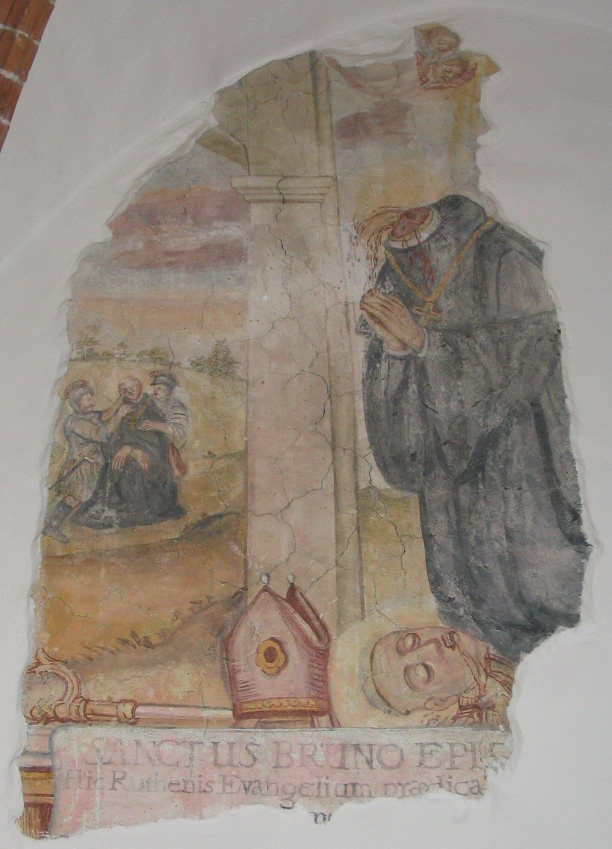- Bruno of Querfurt
Infobox Saint
name=Saint Bruno of Querfurt
birth_date=970
death_date=death date|1009|2|14|mf=y
feast_day=October 15
venerated_in=Roman Catholic Church 
imagesize=175px
caption=A medieval fresco depicting St Bruno's death
birth_place=Querfurt ,Saxony
death_place=
titles=Bishop and Martyr; Second Apostle of the Prussians
beatified_date=
beatified_place=
beatified_by=Pope=
canonized_date=
canonized_place=
canonized_by=
attributes=
patronage=
suppressed_date=
issues=
prayer=
prayer_attrib=Saint Bruno of Querfurt (c. 970 –
February 14 1009 ) (also known as "Brun" and "Boniface" [Cite web
title=St. Bruno of Querfurt|publisher=The Catholic Encyclopedia, Volume III. Published 1908. New York: Robert Appleton Company. |author=Nihil Obstat, November 1, 1908 |url=http://www.newadvent.org/cathen/03018a.htm|accessdate=2008-05-08] ) is a saintedmissionary bishop and martyr, who was beheaded near the border ofKievan Rus andLithuania while trying to spread Christianity in Eastern Europe. He is sometimes called the second Apostle of theOld Prussians .Biography
Early life
Bruno was from a noble family of
Querfurt ,Saxony . He is rumored to have been a relative of the Holy Roman Emperor Otto III. At the age of six he was sent to be educated inMagdeburg , seat ofAdalbert of Magdeburg , the teacher and namesake ofSaint Adalbert . While still a youth he was made a canon of Magdeburg cathedral. The fifteen-year-old Otto III made Bruno a part of his royal court. While in Rome for Otto's imperial coronation, Bruno met Saint Adalbert of Prague, the first Apostle of the Prussians, killed a year later, which inspired Bruno to write a biography of St Adalbert when he reached the recently Christianized and consolidatedKingdom of Hungary himself. Bruno spent much time at the monastery where Adalbert had become a monk and where abbotJohn Canaparius may have written a life of Saint Adalbert. Later, Bruno entered a monastery nearRavenna , founded by Otto, and underwent severeascetic training under the guidance of St. Romuald.Missionary life
In Otto III hoped to open a monastery between the
Elbe and theOder (somewhere in thepagan lands that became Brandenburg or WesternPomerania ) to help convert the local population into Christianity. In 1003Pope Sylvester II appointed Bruno, at the age of 33, to head a mission amongst the pagan peoples of Eastern Europe. Owing to a regional conflict between the Holy Roman Emperor Henry II and Duke Boleslaus I of Poland he delayed the plans for the monastery, and so Bruno set out forHungary . There he went to the places that Saint Adalbert of Prague had attended. Bruno tried to convertAhtum , the Duke ofBanat , who was an Eastern Orthodox Christian to Catholicism, but this precipitated a large controversy leading to organized opposition from Orthodox monks. Bruno elected to gracefully exit the region after he first finished his book, the famous "Life of St. Adalbert," a literary memorial of much worth giving a history of the (relatively recent) conversion of the Hungarians.After this diplomatic failure, Bruno went to
Kiev , where Grand Duke Vladimir I authorized him to makeChristian converts among thePechenegs , semi-nomadicTurkic peoples living between theDanube and the Don rivers. Bruno spent five months there and baptized some thirty adults. He helped to bring about a peace treaty between them and the ruler of Kiev.Before leaving for Poland, Bruno consecrated a bishop for the
Pechenegs . While in Poland he consecrated the firstBishop of Sweden . Bruno found out that his friend Benedict and four companions had been killed by robbers in 1003. Bruno took eyewitness accounts and wrote down a touching history of the so-called Five Martyred Brothers.Mission to Prussia and death
In the autumn or at the end of 1008 Bruno and eighteen companions set out to found a mission among the Prussians; they succeeded in converting Netimer, a "king of Prussians", and then traveled to the east, heading very likely towards Yotvingia. Yotvingia was a region then subordinate to
Kievan Rus (since 983), that intersected the borders of what was thenOld Prussia , Kievan Rus and theDuchy of Lithuania . [According to the "Annals of Magdeburg" (c. 1170) and some other sources.]Saint Bruno was beheaded on
February 14 ,1009 , where as most of his companions were hanged the same day (according to Bruno's companion Wibert, Bruno was killed by "a duke of some part of Prussia.") DukeBoleslaus the Brave brought the bodies to Poland (it was supposed that they were laid to rest inPrzemyśl , where some historians place Bruno's diocese; such localization of the Bruno's burial place is hardly probable because Przemyśl then belonged to Orthodox Kievan Rus through 1018). The "Annals of Magdeburg," "Thietmar of Merseburg's Chronicle," various works of Magdeburg Bishops, the "Annals of Quedlinburg " and many other written sources of XI-XV centuries record this story.Soon after his death, Bruno and his companions were venerated as martyrs and Bruno was soon after
canonized . It was said thatBraunsberg was named after St Bruno.References
* [http://www.newadvent.org/cathen/03018a.htm Catholic Encyclopedia: "St. Bruno of Querfurt"]
Wikimedia Foundation. 2010.
